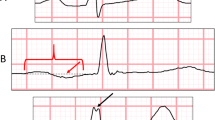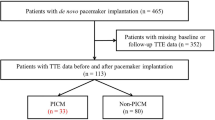Abstract
Background
Interatrial block (IAB), defined as a conduction delay between the right and left atrium, is manifested on the electrocardiogram as a prolonged P-wave duration. Large number of studies recently have been published regarding the prevalence of IAB and its associations with the risk of atrial fibrillation and ischemic stroke. Cardiovascular diseases are the leading causes of mortality in chronic kidney disease (CKD). In this study, we aimed to investigate echocardiographic predictors of IAB in patients with severe CKD.
Methods
This study enrolled a total of 155 patients [male: 95 (61.3%), mean age: 56.3 ± 12.8 years] with severe CKD (glomerular filtration rate < 30 mL/min). All patients were evaluated by electrocardiography and transthoracic echocardiography. IAB was defined as P wave duration of ≥ 120 ms on electrocardiography.
Results
Electrocardiography revealed IAB in 54 patients. The baseline demographic characteristics of the patients were similar in both groups with and without IAB. Left atrial diameter (LAD), left ventricular end-systolic and end-diastolic diameters, interventricular septal thickness, posterior wall thickness, left ventricular mass, left ventricular mass index (LVMI), and the prevalence of left ventricular hypertrophy were found to be significantly increased in patients with IAB. Increased LAD (OR = 1.119; 95% CI 1.019–1.228; p = 0.019) and LVMI (OR = 1.036; 95% CI 1.003–1.070; p = 0.031) were found to be independent predictors of IAB.
Conclusion
A significant association exists between the presence of IAB and echocardiographic parameters related to left ventricular hypertrophy and left atrial dilatation. Presence of IAB may be an additional and easy diagnostic marker for risk stratification of patients with severe CKD.




Similar content being viewed by others
References
Parekh RS, Carroll CE, Wolfe RA, Port FK (2002) Cardiovascular mortality in children and young adults with end-stage kidney disease. J Pediatr 141:191–197
Saeed F, Arrigain S, Schold JD, Nally JV Jr, Navaneethan SD (2019) What are the risk factors for one-year mortality in older patients with chronic kidney disease? An analysis of the cleveland clinic CKD registry. Nephron 141(2):98–104
Wang AY (2007) Cardiovascular risk factors in peritoneal dialysis patients revisited. Perit Dial Int 27(Suppl 2):S223–S227
García-López E, Carrero JJ, Suliman ME, Lindholm B, Stenvinkel P (2007) Risk factors for cardiovascular disease in patients undergoing peritoneal dialysis. Perit Dial Int 27(Suppl 2):S205–S209
Bayés de Luna A, Platonov P, Cosio FG et al (2012) Interatrial blocks. A separate entity from left atrial enlargement: a consensus report. J Electrocardiol 45:445–451
Conde D, Seoane L, Gysel M et al (2015) Bayés’ syndrome: the association between interatrial block and supraventricular arrhythmias. Expert Rev Cardiovasc Ther 13:541–550
Nielsen JB, Kühl JT, Pietersen A et al (2015) P-wave duration and the risk of atrial fibrillation: results from the Copenhagen ECG study. Heart Rhythm 12:1887–1895
O’Neal WT, Zhang ZM, Loehr LR et al (2016) Electrocardiographic advanced inter-atrial block and atrial fibrillation risk in the general population. Am J Cardiol 117:1755–1759
Martínez-Sellés M, Robledo LA, Baranchuk A (2017) Interatrial block and the risk of ischemic stroke. J Atheroscler Thromb 24(2):185–186
O’Neal WT, Kamel H, Zhang ZM et al (2016) Advanced interatrial block and ischemic stroke: the atherosclerosis risk in communities study. Neurology 87:352–356
Ariyarajah V, Kranis M, Apiyasawat S, Spodick DH (2007) Potential factors that affect electrocardiographic progression of interatrial block. Ann Noninvasive Electrocardiol 12(1):21–26
Pang H, Ronderos R, Pérez-Riera AR, Femenía F, Baranchuk A (2011) Reverse atrial electrical remodeling: a systematic review. Cardiol J 18(6):625–631
Scharer K, Schmidt KG, Soergel M (1999) Cardiac function and structure in patients with chronic renal failure. Pediatr Nephrol 13:951–965
McCullough PA, Assad H (2012) Diagnosis of cardiovascular disease in patients with chronic kidney disease. Blood Purif 33:112–118
Solak Y, Gul EE, Kayrak M et al (2013) Electrocardiographic P-wave characteristics in patients with end-stage renal disease: P-index and interatrial block. Int Urol Nephrol 45(2):511–517
Friedewald WT, Levy RI, Fredrickson DS (1972) Estimation of the concentration of low-density lipoprotein cholesterol in plasma, without use of the preparative ultracentrifuge. Clin Chem 18(6):499–502
Levey AS, Bosch JP, Lewis JB, Greene T, Rogers N, Roth D (1999) A more accurate method to estimate glomerular filtration rate from serum creatinine: a new prediction equation. Modification of diet in renal disease study group. Ann Intern Med 130(6):461–470
Go AS, Chertow GM, Fan D, McCulloch CE, Hsu CY (2004) Chronic kidney disease and the risks of death, cardiovascular events, and hospitalization. N Engl J Med 351:1296–1305
Saran R, Robinson B, Abbott KC et al (2017) US Renal Data System 2016 annual data report: epidemiology of kidney disease in the United States. Am J Kidney Dis 69(3 Suppl 1):A7–A8
Eckardt KU (1999) Cardiovascular consequences of renal anaemia and erythropoietin therapy. Nephrol Dial Transplant 14:1317–1323
Juan-Garcia I, Puchades MJ, Sanjuan R et al (2012) Echocardiographic impact of hydration status in dialysis patients. Nefrologia 32:94–102
Poulikakos D, Ross L, Recio-Mayoral A et al (2014) Left ventricular hypertrophy and endothelial dysfunction in chronic kidney disease. Eur Heart J Cardiovasc Imaging 15:56–61
Ky B, Shults J, Keane MG et al (2013) FGF23 modifies the relationship between vitamin D and cardiac remodeling. Circ Heart Fail 6:817–824
London GM, Fabiani F, Marchais SJ et al (1987) Uremic cardiomyopathy: an inadequate left ventricular hypertrophy. Kidney Int 31:973–980
Berk BC, Fujiwara K, Lehoux S (2007) ECM remodeling in hypertensive heart disease. J Clin Invest 117:568–575
Paoletti E, De Nicola L, Gabbai FB et al (2016) Associations of left ventricular hypertrophy and geometry with adverse outcomes in patients with CKD and hypertension. Clin J Am Soc Nephrol 11:271–279
Eckardt KU, Scherhag A, Macdougall IC et al (2009) Left ventricular geometry predicts cardiovascular outcomes associated with anemia correction in CKD. J Am Soc Nephrol 20:2651–2660
Paoletti E, Specchia C, Di Maio G et al (2004) The worsening of left ventricular hypertrophy is the strongest predictor of sudden cardiac death in haemodialysis patients: a 10 year survey. Nephrol Dial Transplant 19:1829–1834
Tsao CW, Gona PN, Salton CJ et al (2015) Left ventricular structure and risk of cardiovascular events: a Framingham Heart Study cardiac magnetic resonance study. J Am Heart Assoc 4:e002188
Kahan T, Bergfeldt L (2005) Left ventricular hypertrophy in hypertension: its arrhythmogenic potential. Heart 91:250–256
Alexander B, Baranchuk A, Haseeb S et al (2018) Interatrial block predicts atrial fibrillation in patients with carotid and coronary artery disease. J Thorac Dis 10:4328–4334
Çinier G, Tekkeşin Aİ, Genç D et al (2018) Interatrial block as a predictor of atrial fibrillation in patients with ST-segment elevation myocardial infarction. Clin Cardiol 41:1232–1237
Boles U, Almuntaser I, Brown A, Murphy RR, Mahmud A, Feely J (2010) Ventricular activation time as a marker for diastolic dysfunction in early hypertension. Am J Hypertens 23(7):781–785
Sigwart U, Grbic M, Goy JJ, Kappenberger L (1990) Left atrial function in acute transient left ventricular ischemia produced during percutaneous transluminal coronary angioplasty of the left anterior descending coronary artery. Am J Cardiol 65:282–286
Rodriguez M, Lorenzo V (2009) Progress in uremic toxin research: parathyroid hormone, a uremic toxin. Semin Dial 22:363–368
Mitsnefes MM, Kimball TR, Kartal J et al (2005) Cardiac and vascular adaptation in pediatric patients with chronic kidney disease: role of calcium-phosphorus metabolism. J Am Soc Nephrol 16:2796–2803
Jono S, Nishizawa Y, Shioi A, Morii H (1997) Parathyroid hormone related peptide as a regulator of vascular calcification. Its inhibitory action on in vitro calcification by bovine vascular smooth muscle cells. Arterioscler Thromb Vasc Biol 17:1135–1142
Lipscombe D (2002) L-type calcium channels. High and new lows. Circ Res 90:933–935
Nitta K, Yajima A, Tsuchiya K (2017) Management of osteoporosis in chronic kidney disease. Intern Med 56(24):3271–3276
Funding
No financial funding was received for this study.
Author information
Authors and Affiliations
Contributions
All of the authors contributed planning, conduct, and reporting of the work. All authors had full access to all data in the study and take responsibility for the integrity of the data and the accuracy of the data analysis.
Corresponding author
Ethics declarations
Conflict of interest
All of the authors have no conflict of interest.
Additional information
Publisher's Note
Springer Nature remains neutral with regard to jurisdictional claims in published maps and institutional affiliations.
Rights and permissions
About this article
Cite this article
Kalçık, M., Yetim, M., Doğan, T. et al. Echocardiographic predictors of interatrial block in patients with severe chronic kidney disease. Int Urol Nephrol 52, 933–941 (2020). https://doi.org/10.1007/s11255-020-02430-0
Received:
Accepted:
Published:
Issue Date:
DOI: https://doi.org/10.1007/s11255-020-02430-0




